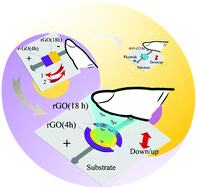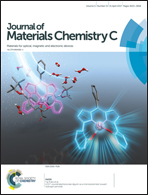Combining the converse humidity/resistance response behaviors of rGO films for flexible logic devices†
Abstract
Carbon nanomaterials have excellent humidity sensing performance. Here, we demonstrate that reduced graphene oxide (rGO)-based conductive films with different thermal reduction times have gradient and invertible humidity/electrical resistance responses: rGO films (<11 h, negative response, regarded as a signal of “0”), rGO films (around 11–13 h, balance point) and rGO films (>13 h, negative response, regarded as a signal of “1”). We propose a new mechanism that describes a “scale”-like model for rGO films to explain these behaviors based on contributions from Ohm-contact resistance and capacitive reactance at interplate junctions, and intrinsic resistances of the nanoplates, respectively. This mechanism is accordingly validated via a series of experiments and electrical impedance spectroscopies, which complement more classical models based on proton conductivity. To explore the practical applications of the converse humidity/resistance responses, three simple flexible logic devices were developed, (i) a rGO pattern for a humidity-insensitive conductive film, which has the potential to greatly improve the stability of the carbon-based electrical device to humidity; (ii) a Janus pattern of rGO films for gesture recognition, which is very useful to human/machine interactions; (iii) a sandwich pattern of rGO films for 3-dimensional (3D) noncontact sensing, which will be complementary to the existing 3D touch technique.



 Please wait while we load your content...
Please wait while we load your content...